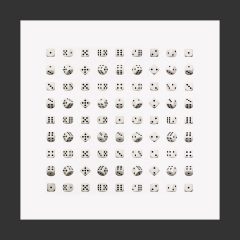HASARD et NECESSITE (2000)
J’ai appris récemment ( par hasard ), que le mot hasard provenait de l’arabe et signifiait…un dé !
La célèbre phrase d’Einstein : » Dieu ne joue pas au dés » prend alors un sens bouleversant et éclaire parfaitement son opposition aux thèses statistiques et probabilistes de la mécanique quantique.
Que désirer d’autre, à mon échelle, que jouer à faire de la photographie mathématique, pour essayer de ranger le désordre du hasard ?
À partir de la face » 1 « , le jeu consistait à photographier un dé en le faisant tourner systématiquement de 45° après chaque prise de vue, à faire l’inventaire de ces 64 phases, et à rassembler les résultats dans une sorte de matrice ordonnée. J’obtenais un grand carré magique où les quatre coins extrêmes étaient bien les » 1 « , mais où, à ma grande surprise, deux lignes horizontales répétaient inlassablement les faces » 2 « et » 5 » !…
Un ami, vrai mathématicien, m’a doucement expliqué qu’il y avait là rien de plus normal puisque la somme des deux faces opposées d’un dé fait toujours 7 (ici 2+5), et qu’une autre face de départ que le » 1 » aurait fait apparaître deux autres lignes horizontales étranges dont la somme des faces répétées eut toujours fait 7 .
Comme quoi, jouer n’est pas toujours si futile…
1 élément 60 x 60 cm. Montage de 81 clichés. Épreuves au chlorobromure d’argent avec virage
I recently learnt, by chance, that the word hazard comes from the arabic for chance or … dice! So Einstein’s famous phrase: «god doesn’t play dice» becomes more meaningful and clarifies perfectly his opposition to statistical and probabilist theses of quantum mechanics. What more could I want, in my small way, than to play at mathematical photography in an attempt to tidy up the chaos of hazard? Starting with face 1, the game consisted in photographing a dice and turning it systematically by __° after each shot, to make an inventory of its 6_ phases, and reassembling the results in a kind of ordered matrix. I obtained a big magic square where the four corners did indeed contain a 1, but where, to my great surprise, two horizontal lines untiringly repeated the faces 2 and 5 !… A friend of mine, who is a real mathematician, kindly explained to me that nothing could be more normal, since the sum of any two opposite faces is always 7, and that by starting with a face other than 1 would have given two other horizontal lines where the sum of the repeated faces would still have been 7 .
Sometimes playing about can teach you something useful…
1 element 60 x 60 cm. Montage of 81photographs. Silver chlorobromide prints with toning.

